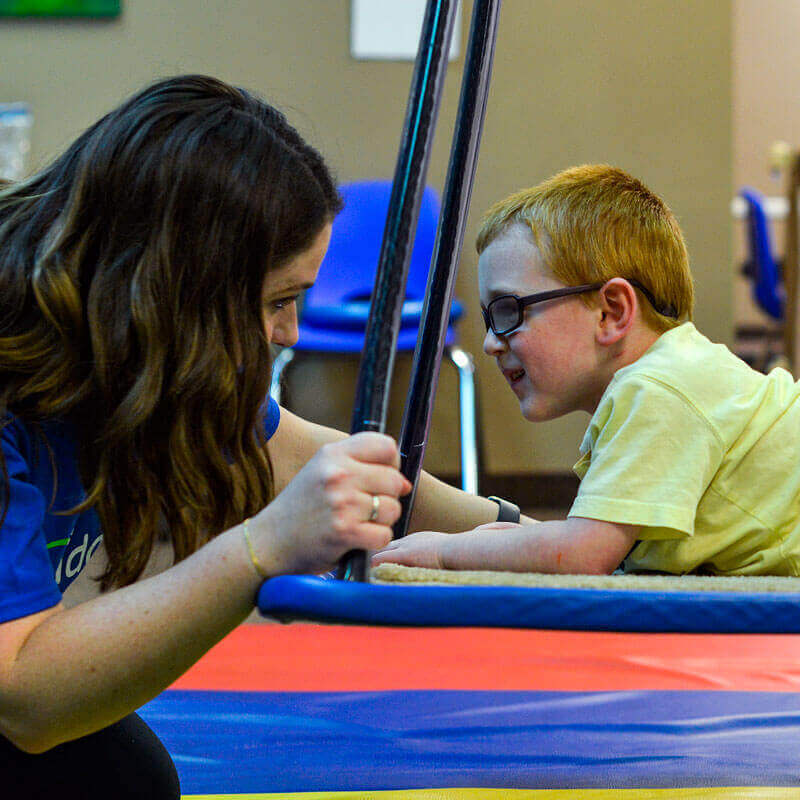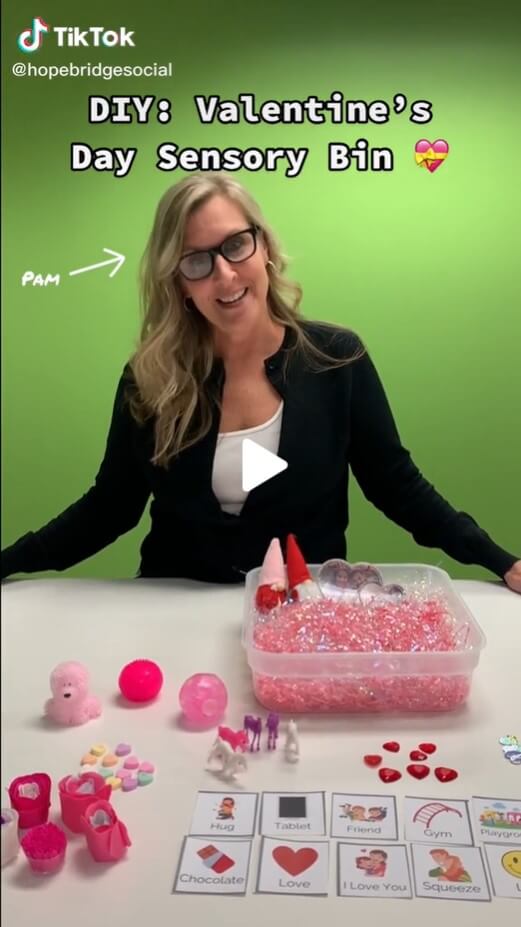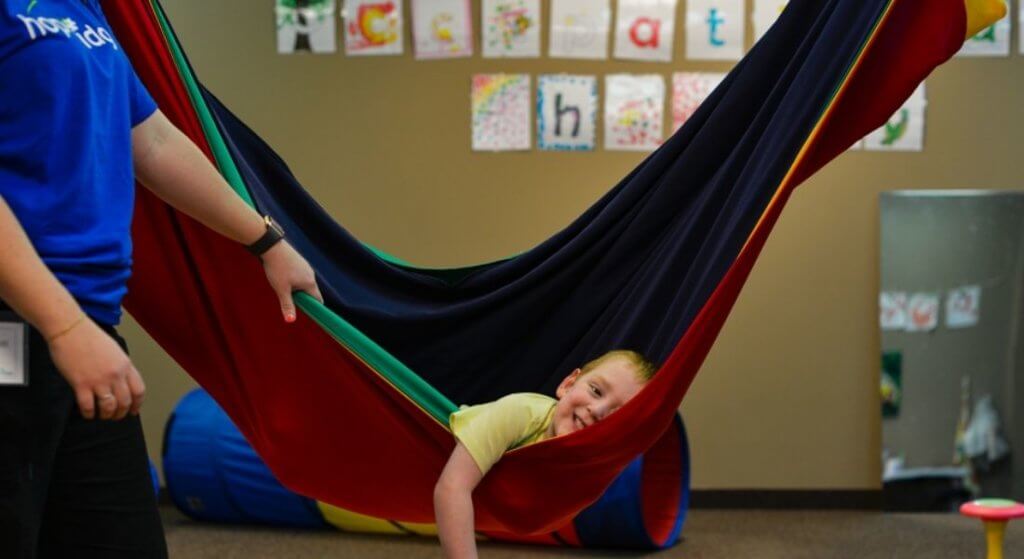Time for an Occupational Therapy Evaluation? Here’s What to Expect
April 26, 2022
April 26, 2022

Is an occupational therapy (OT) evaluation on your calendar? If not, is OT a service you are considering for your child? Either way, we know you might be wondering what to expect.
For some of you, evaluations may be nothing new. From autism testing to evaluations for ABA or speech therapy, your child may have already gone through various assessments. For others, the OT evaluation might be the first step in the equation.

The occupational therapy evaluation is different than a diagnostic evaluation for autism, so we chatted with Hopebridge Occupational Therapy Clinical Specialist Pamela Skinner to outline the process. She helped us create a guide for parents, including what it looks like at our centers, why it’s important, and how to prepare for it.
If you’re still in the early stages of considering whether occupational therapy is right for your child, it never hurts to seek out an evaluation. That initial meeting can help guide parents in the right direction.
Often times, caregivers seek an occupational therapy evaluation due to developmental delays. It is appropriate for kids who could benefit from extra support around self-care, play skills, dressing skills, feeding aversions, sensory processing, toileting, fine motor skills and age-appropriate activities of daily living (ADL).
“Through occupational therapy, we can isolate the deficits to give a child the tools they need to be able to focus on functional tasks, play and interact with their peers,” said Pamela. “If we can help that child gain independence, it also decreases the need for caregiver assistance.”
Unlike applied behavior analysis (ABA therapy), a diagnosis for autism spectrum disorder (ASD) is not necessary prior to beginning occupational therapy, but an OT evaluation is required at the start. Hopebridge provides occupational therapy for children with ASD, as well as those without the diagnosis, though many parents use our centers as a one-stop-shop for complementary services like autism testing, OT, ABA and speech therapy.
The evaluation is an opportunity for the occupational therapist to learn more about the child and family so we can work together to develop the best possible goals for therapy. Our team also shares the results of the evaluation with insurance providers as support for therapy coverage.

To arrange an OT evaluation,* one of Hopebridge’s Care Coordinators will reach out to families to schedule an appointment and work with the families on insurance authorization. Parents can expect the appointment to last approximately one hour. If English is not the family’s preferred language, Hopebridge has interpreters available through LUNA Language Services, which we can arrange in advance. Working with interpreters can extend the length of the appointment, so parents should be prepared to spend extra time if they choose to use these services.
Once scheduled, the therapist usually reaches out ahead of time to provide caregivers with pre-appointment assessments, which are sent digitally. Parents and guardians should fill out the questionnaires prior to the appointment.
One of these parent reports could include the Roll Evaluation of Activities of Life (REAL). It is important that parents fill this out in advance, because when it comes to certain areas, parents may be able to give us a better idea of what is going on at home than what we can view in person.
“It can be difficult to have kids demonstrate certain skills like dressing and undressing in the initial evaluation, though many of our centers have cute costumes to help with this part. The task of putting on and taking off shoes and socks are less invasive when first meeting a kiddo, but we still lean in on the REAL to capture the parent report prior to the appointment,” said Pamela.
If the referral for occupational therapy alludes to sensory challenges, Hopebridge will also send a sensory profile. This tool helps paint a picture of what the child might be presenting with regarding sensory processing and regulation.
In addition to the questionnaires, parents can prepare for the evaluation by jotting down any extra information that could be beneficial to share at the appointment. For example, a list of the child’s likes and dislikes can help the therapist increase engagement during the evaluation. It is also a good idea to provide details around medical history and any history of therapy in the child’s life, including contacts so we can arrange a release of information to expand upon their work or collaborate with current providers.
On the day of the OT evaluation, a registered occupational therapist (OTR) will greet the child and caregiver.

It can be helpful for the parent to be present. This is not always possible, as some of the families seeking occupational therapy are already participating in ABA therapy in our centers and may be assessed around their sessions, but having caregivers available at the appointment is a great way to get more insight into the child’s abilities and deficits. For example, parents can share that their child is not able to use the toilet, has delays in fine motor skills or won’t make eye contact. Parents have the option to be present in the evaluation area or in the waiting room, though sometimes children may be less likely to engage when parents are in the same room.
During the appointment, the therapist will conduct their clinical assessment to support the parent reports. Which assessment is used, while always a standardized tool of measurement, may vary between centers, therapists and children. The assessment used might be the Peabody Developmental Motor Scales (PDMS-), Bruininks-Oseretsky Test of Motor Proficiency (BOT-2) or Beery Visual-Motor Integration (VMI).
These assessments have children perform tasks, which to the parent, may sometimes appear like playing, as playing is our kids’ main job! For instance, during the PDMS, the therapist might ask the child to stack blocks or write a few things, depending upon their age. They might encourage them to pick out a toy and use this time to assess their grip and pinch patterns while watching how they manipulate the toys. Much of the focus is on dexterity and capability of fine motor skills to determine their abilities and deficits.
“This clinical impression portion is the meat and potatoes of the evaluation. It shows us the child’s skills and abilities, as well as areas where there may be deficits. This part of the evaluation emphasizes more than the standard written or digital assessment, plus leaves space for therapist interpretation,” said Pamela.
Once the OT has finished the assessments, they begin to set long- and short-term goals. If the parent is present, they work together, though therapists can also use the subjective information they provided in the questionnaires to develop goals.
“We want that feedback from parents. It’s important to know what the child is and isn’t able to do, but it’s just as significant to know what parents would like them to be able to do,” said Pamela.
Goals will vary from child to child. One example of a goal could be tolerance to sit at the table to eat. Another could be overcoming a food aversion. Pamela says toileting is a big goal for families, and one that often involves collaboration between OT and ABA therapy teams, which is important since children who are involved in ABA will likely spend more time in those sessions.

After the evaluation, therapists write up the plan and work with the child’s physician for their sign-off, then our care coordinators will send it to insurance. Availability at the local Hopebridge center will help determine the start date for services. Once Hopebridge receives approval from the insurance company, we can plan the start date, of which a Care Coordinator or center manager will reach out to confirm.
If you believe your child could benefit from occupational therapy, autism testing or other interdisciplinary services,* we urge you not to wait. Having more information about your child’s development can benefit your child’s growth during these pivotal years to help them flourish now and later in life. Contact us now to arrange evaluation for the services that are best for your family at one of our locations around the country.
*Informed consent was obtained from the participants in this article. This information should not be captured and reused without express permission from Hopebridge, LLC. Testimonials are solicited as part of an open casting call process for testimonials from former client caregivers. Hopebridge does not permit clinical employees to solicit or use testimonials about therapeutic services received from current clients (Ethics Code for Behavior Analysts 5.07-5.08; BACB, 2020). Hopebridge does not provide any incentives, compensation, or renumeration for testimonials provided by a former client or client caregiver.
Autism Therapy
October 02, 2020
Community Donations Spark Real-Life Learning Opportunities for Kids with Autism
Autism Therapy
July 08, 2020
Hopebridge Autism Therapy Center Becomes Official ACE Provider
Autism Therapy
October 21, 2019
New Study Shows Earlier Screening for Autism can Positively Impact Child Development